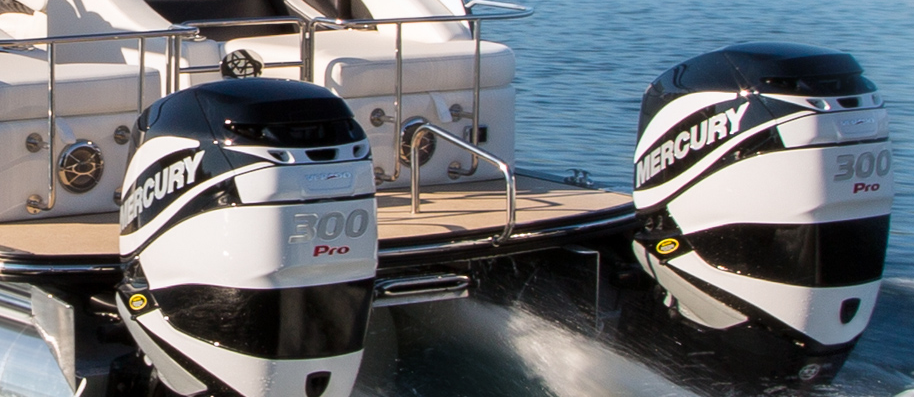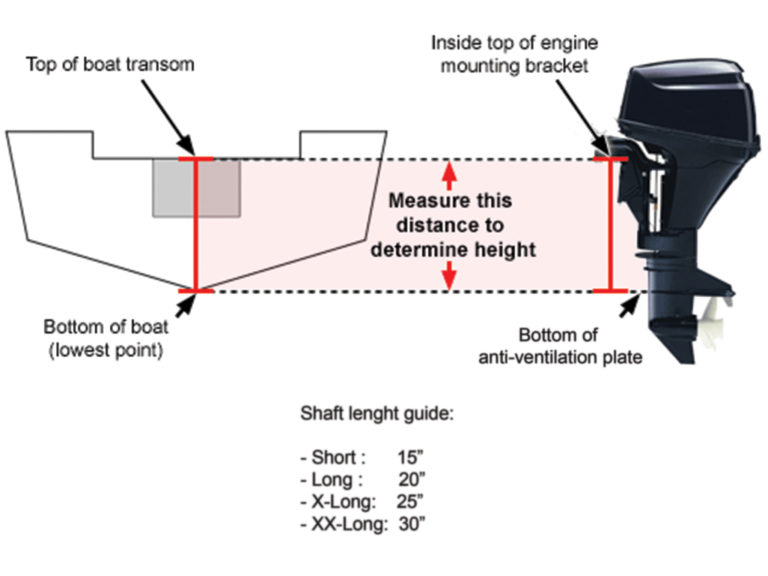Guide to Boat Transom Heights & Outboard Shaft Lengths
Whether your on a pontoon boat, fishing boat, or speedboat boating is always one of the best times you can have.
As summer approaches there will be more boaters taking to the water.
Among them will be first-timers boaters or those who have recently purchased their boats.
Buying a boat can be an exciting purchase. With it comes a lot of responsibility and new boating things to learn including boat maintenance and boat basics.
in this blog, Marine Parts Warehouse will guide you in how to get the right outboard shaft length for the boat transom height.
One of the great things about an outboard motor is how versatile it is. An outboard motor can drive just about any sort of boat with proper mounting.
Beyond motorboats designed for large outboards, you will see outboards hanging on the sterns of everything from small canoes to large cruising sailboats. Many single-engine boats mount a smaller auxiliary motor for emergency use.

No matter what size of boat you are running, one of the most critical choices you can make when buying an outboard motor is the shaft length.
All boats are different, and the motor manufacturers produce a variety of standard lengths. Finding the right size is a matter of looking at what you’ve got and taking out the measuring tape. But, how do you measure it?
Before we get started let’s see what a boat transom is and what it does. The transom is the flat vertical section at the rear of the boat. It is where the outboard is mounted, and some boat owners place the name of the boat.
The height of the transom is calculated by measuring from the bottom of the hull to the top of the transom, using the center line.
It is extremely important that the boater understands the significance of the transom’s height.
The height of the boat transom dictates the size of the outboard motor. The motor is what powers the boat so the two go hand-in-hand.
If the height of the boat transom is off it can cause major issues. A reverse transom that sits too high can impact the propellers of the motor and motor bracket. The propellers will also have trouble reaching the water.
When the boat transom is too low, the motor could end up underwater.
How to Measure Transom Height
For vessels with transom-mounted outboards, you can easily figure out which type of outboard you need to get.
Measure from the top of the transom to the bottom of the hull.
Your goal is to measure how the outboard will sit, so start from the clamping plate and follow the centerline of the hull.
Measure straight down to the lowest point on the hull. For vee-shaped hulls, the lowest spot of the hull will come to point, while on flat-bottomed boats it will be more or less level.
The lowest point will likely be directly under your drain plug if you’ve got one. If you are running a twin-engine setup, then measure the same distance from each clamping plate to the bottom of the hull. This number will likely be shorter than that for a single-engine installation since you do not necessarily measure to the point of the keel.

As mentioned above, the operation of the propeller relies on the transom height. To achieve this, the motor itself has to be attached at the correct height.
For boats equipped with a bracket, calculate the same measurement but based on the bracket and not the transom. Wherever the outboard clamping bracket is, use this as the basis for measurement.
If your boat is newer and the manufacturer is still in business, you might also want to try to give them a call. Chances are the boat was designed with a specific size of outboard in mind. If you are looking to repower, they may be able to offer some sage advice.
Check the literature about your model boat online, and you may be surprised to find that the number is published for you.
It’s still smart to measure it yourself though, just in case, the design changed over the years. With such an important, long-term, and expensive upgrade, it’s never a bad idea to double-check.
How to Measure an Outboard Shaft
If you’re going the other way around and trying to figure out how long the shaft on your outboard is, measuring it is equally easy.
This is handy if you’re shopping for second-hand outboards or looking to sell the one that came with your boat.
Use the mounting bracket on the motor to know where it will sit on the boat. The flat part of the bracket that rests on the transom when mounted will give you the same point of reference as the transom does on the boat.
Measure from there down to the top of the cavitation plate, also known as the anti-ventilation plate. The cavitation plate is the horizontal surface of the lower unit immediately above the propeller.
The outboard model number also has a code system to determine certain features of the outboard including the shaft length. please visit www.yearofmyoutboard.com to see a comprehensive list of outboard model and serial numbers.
If you’d like to see this in video format, skip to 0:44 in the below YouTube Video:
Short vs. Long Shaft
Outboard motors can be fitted to a variety of boats, so manufacturers have standardized their engines to go on virtually anything. You can order an outboard in lengths ranging from 15 inches to 30 inches, depending on its power output and possible uses.
Industry standards dictate that for short shaft engines the transom height should be 15″. A long shaft engine requires a height of 20″ and extra-long shaft engines will need a transom height of 25″.
While this is the case there is certain saltwater motors that are extra extra long at 30″.
Since the length of the shaft of your outboard is associated with the size boat, smaller engines will generally have shorter shafts.
Small portable outboards ranging from 2 to 20 horsepower are usually sold only in short or long shaft versions. High powered boats usually only come in long and extra-long variants.
For really big boats, the biggest and baddest six- or eight-cylinder outboards can have “extra-extra long” shafts up to 30 inches.
Beginning boaters should be aware of the boat’s measurements.
Keep these numbers in mind if you ever have a need for a new outboard motor for your boat.
Mounting the outboard motor in accordance with the industry standards is important. However, there may be times when a boater strays away from these recommendations.
Knowing how this can affect the overall operation of the boat is a factor to be considered.
Marine Parts Warehouse has jack-plate extensions to allow adjustments without buying a new motor: Jack Plate Extensions
The Effects of Standard, Lower and Higher Outboard Mounting.
Generally, the anti-ventilation plate on most engines is aligned with the bottom of the vessel. This is measured by the propeller shaft being parallel to the vessel’s bottom.
The outboard comes with mounting holes and brackets. These are vertically aligned so the boater can make adjustments.
As with anything, there are exceptions to the rule. If you decide to make adjustments, please consult a marine engine dealer about the boat design.
In lower mounting, the engine is set lower than the recommended standard. Doing this can have adverse effects.
Mounting the motor lower on the boat transom can create excessive spray, increase case drag, reduce underwater clearance, and negatively impact faster boats. It also cuts into speed and fuel efficiency. This could also affect your travelling capabilities on the boat trailer. It is possible that the motor could hang low while transporting on the boat trailer causing future boat repairs.
There is a simple test to see if your outboard motor is set at the best height. Simply start with the engine in idle, followed by trimming the motor out by one-half to full trim. Safely but briskly accelerate. If the propeller fails to ventilate, the motor is mounted to low.
There are instances where a lower mount may be okay. Some fishing boats can handle the motor being underwater. This, however, is not recommended for the beginning boater.
Higher mounting decisions should be left to the professionals. One of the main concerns is causing the engine to overheat if not enough water reaches the engine to keep it cool.
The boater must also consider if the boat transom support is designed to bear the weight of a higher mount. No one wants to have issues with a new transom or boat repairs.
Boaters who consider going with a higher mount can see increased speeds. It can also improve the experience of driving a faster boat. Increased RPM and additional horsepower feed the need for speed. This alone can outweigh the negatives when deciding to adjust the mount upwards.
On the downside, a higher mount can interfere with the boaters steering capabilities.
All things considered, sticking with the industry standard is best for the beginner. Always weigh the risks of making adjustments.
FAQs About Outboard Shaft Length
Is it OK to put a long shaft outboard on a boat that’s rated for a short shaft?
A: The short answer is – Yes. You can use a longer shaft than recommended and your boat will work fine. However, your boat will have slightly more drag which will reduce your maximum speed. You’ll also want to pay attention when you’re in shallow water because your prop will be lower than normal.
What types of boat need a short shaft?
A: The answer varies by boat, but here are some rules of thumb for matching a short shaft outboard to your boat. If you have a small boat with a 15 to 17 inch aft transom, you’ll most likely need a short shaft outboard. Other boats that need short shafts are:
- Small Sailboats and small Jon boats
- Sailboats with movable brackets
- Zodiacs and other inflatables
- Canoes
What types of boat need a long shaft?
- Pontoon boats
- Carolina Skiffs
What types of boat need an extra long shaft?
A: Any boat that has a 21 to 27 inch aft transom will need an extra long shaft outboard. Other boats that need extra long shafts are:A: If you have a small boat with a 18 to 21 inch aft transom, you’ll most likely need a long shaft outboard. Other boats that need long shafts are Sailboats Barges that need a lot of thrust
If you have a fast boat, getting the outboards cavitation plate at the same level of the hull will ensure quick hole shot and fast top-end speeds. Owners of bass boats, RIBs, or offshore fishing boats need to get this right. It will ensure that the outboard’s trim will be effective, and it will save you gas too.
Displacement hulled vessels like sailboats and workboats can benefit from a little more space between the hull and cavitation plate, but not much. Remember, if you use a longer outboard shaft than you need you will be increasing your draft. You also might not be able to lift the outboard out of the water entirely for storage. Repowering your boat is one of the most expensive upgrades you can make. Be sure to measure carefully and research thoroughly before diving in. Happy boating!
To find out more information about products offered by Marine Parts Warehouse, contact us today!
Posted by Art Vandelay

